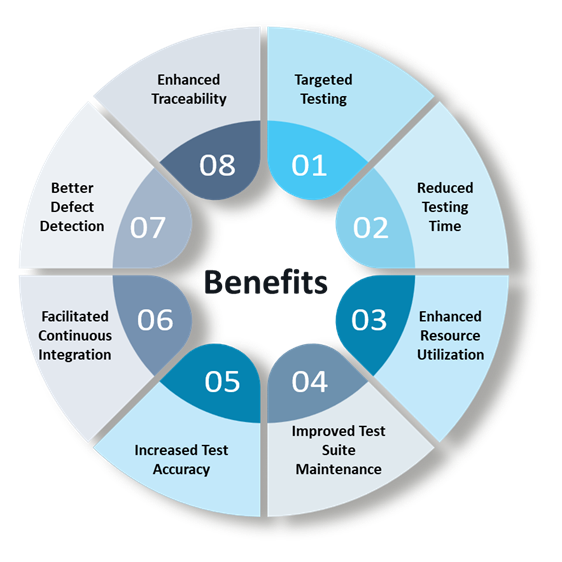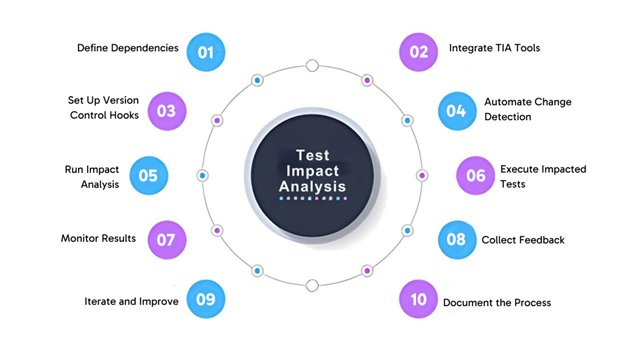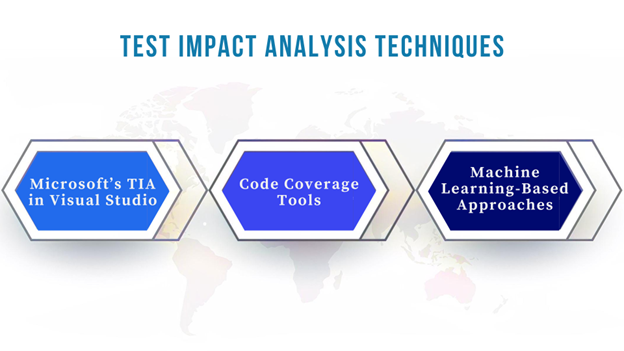As software projects become increasingly complex, teams require faster methods to identify which tests are necessary. This is where Test Impact Analysis (TIA) comes into play.
The global Software Testing and QA Services Market is valued at USD 38,120 million and is projected to expand at a compound annual growth rate (CAGR) of 12.6%, reaching approximately USD 99,105 million by 2032. Significant innovations and the rollout of new offerings drive this growth.
Test impact analysis has emerged as a critical practice for optimizing testing efficiency and aligning it with modern development cycles. It helps reduce unnecessary testing and validate critical parts of the code. Furthermore, TIA assesses which tests are affected by codebase modifications.
In this blog, we will explore the notion of test impact analysis and its significance. We will also examine the methodologies for effectively implementing TIA.
What is Test Impact Analysis (TIA)?
Every second in development counts, and TIA focuses on efficiency, precision, and speed. It ensures you don’t have to test irrelevant system parts. Test impact analysis (TIA) is a systematic approach in software testing that evaluates how codebase changes affect existing test cases.
Test impact analysis (TIA) is beneficial in agile and continuous integration environments where code is frequently modified. Its scope extends to code coverage tools, dependency mapping, and even machine learning to predict and refine which tests to run.
Importance of Test Impact Analysis (TIA) in Agile and Fast-Paced Environments
Test impact analysis is crucial in agile and fast-paced software development environments. Its significance can be attributed to several fundamental aspects:
- TIA allows teams to quickly identify the impact of code changes on existing tests.
- It enables focused testing and determines which tests are relevant to recent changes.
- TIA integrates seamlessly with Continuous Integration and Continuous Deployment (CI/CD) pipelines.
- TIA maps dependencies between code components and test cases.
- TIA streamlines testing workflows, maintaining efficiency amidst rapid iterations.
Challenges in Traditional Testing and How TIA Addresses Them
Traditional testing methodologies face significant challenges that can hinder efficiency and software quality. The following table outlines these challenges and illustrates how Test impact analysis effectively addresses them.
| Challenges in Traditional Testing | How TIA Addresses Them |
| Excessive Test Coverage | TIA executes only impacted tests, optimizing resource use. |
| Slow Feedback Cycles | TIA accelerates feedback by quickly identifying affected tests. |
| Difficulty in Maintaining Test Suites | TIA provides dependency mapping, simplifying test management. |
| High Risk of Regression | TIA ensures relevant tests run without defect introduction. |
| Limited Automation | TIA integrates into automated frameworks for real-time analysis. |
| Lack of Traceability | TIA enhances traceability by linking code changes to specific tests. |
As we move forward, let’s examine the vital reasons that make test impact analysis an indispensable component of an efficient software testing strategy
Benefits of Test Impact Analysis Essential in Software Testing
Test impact analysis is a critical methodology in software testing that helps efficiently manage the complexities of code changes. Here are some benefits of test impact analysis:
- TIA allows teams to focus on executing only the tests impacted by recent code changes.
- TIA significantly reduces the time required for testing.
- Teams can better allocate testing resources.
- TIA facilitates easier maintenance of test cases.
- With TIA, teams can ensure that you align your test efforts with the application’s most critical areas.
- TIA integrates easily with CI/CD pipelines.
- TIA increases the chances of catching defects early in the development cycle.
- TIA establishes a clear link between code changes and their corresponding tests.
Now that we understand how TIA enhances your testing process, let’s examine the practical implementation steps.
How to Implement Test Impact Analysis in a CI/CD Pipeline
You want to implement test impact analysis into your CI/CD pipeline. Here’s how to get started by focusing on the key elements needed to configure and enable TIA efficiently. Here are the steps:
Step 1: Define Dependencies
Map out the dependencies between codebase components and the corresponding test cases. This may involve creating a dependency graph that illustrates how different modules relate to each other and which tests validate specific functionalities.
Step 2: Integrate TIA Tools
Choose a test impact analysis tool that aligns with your development environment and CI/CD framework. Integrate it into your existing CI/CD pipeline to facilitate automated analysis of code changes.
Step 3: Set Up Version Control Hooks
Configure hooks in your version control system (e.g., Git) to trigger TIA whenever changes are committed. This ensures the analysis runs automatically, identifying impacted tests before merging the code.
Step 4: Automate Change Detection
Implement scripts or tools that detect changes in the codebase. This includes identifying newly added, modified, or deleted files and functions. Automating this detection process helps streamline the TIA workflow.
Step 5: Run Impact Analysis
Upon detecting code changes, invoke the TIA tool to analyze their impact on the existing test suite. The tool should determine which tests are affected and prioritize them for execution.
Step 6: Execute Impacted Tests
Configure your CI/CD pipeline to run only the tests identified by TIA as being impacted by the code changes. This selective execution saves time and resources compared to running the entire test suite.
Step 7: Monitor Results
After executing the impacted tests, monitor the results closely. Set alerts for any failures and integrate reporting tools to provide insights into test outcomes.
Step 8: Collect Feedback
Encourage your development and testing teams to provide feedback on the TIA implementation. This will help gauge the effectiveness of the analysis and any challenges encountered during execution.
Step 9: Iterate and Improve
Based on the feedback collected, refine your TIA processes. This may involve adjusting dependency mappings, optimizing automation scripts, or enhancing integration with CI/CD tools.
Step 10: Document the Process
Create comprehensive documentation outlining the TIA implementation steps, configurations, and best practices. This will serve as a valuable resource for current and future team members involved in the CI/CD process.
Having outlined the practical steps for implementing Test Impact Analysis, let’s explore various techniques to enhance its effectiveness.
Test Impact Analysis Techniques
Some techniques and tools can drastically improve the process of effectively implementing test impact analysis. Let’s break down three fundamental approaches to consider, ranging from traditional code coverage to advanced machine learning methods.
1. Microsoft’s TIA in Visual Studio
Microsoft’s implementation of TIA is one of the most recognized and widely used in the industry. Visual Studio has a built-in TIA tool that integrates seamlessly with CI/CD pipelines like Azure DevOps.
Every time a new build is triggered, Visual Studio performs an analysis to identify which parts of the code have changed. Based on this analysis, only the tests covering the impacted code areas are selected and executed. This process drastically reduces the time required to run a full regression suite.
2. Code Coverage Tools
Code coverage is another critical component of TIA, especially for teams that want more granular control over the tests to run. Code coverage enables teams to quickly identify the most impacted areas and focus your testing efforts there.
Code coverage tools like JaCoCo, Cobertura, or OpenCover track which lines of code are executed during test runs. When a code change is introduced, these tools help identify the parts of the codebase that are affected by the change.
3. Machine Learning-Based Approaches
In recent years, the rise of machine learning (ML) has revolutionized the way we perform TIA. Machine learning algorithms can study historical test data to predict which tests are likely to fail based on code changes.
ML-based tools analyze past builds and test results to learn which types of changes tend to affect specific parts of the system. Over time, these models become more accurate, allowing the system to prioritize and predict which tests to run. This dynamic, data-driven approach optimizes test selection far beyond traditional methods.
Whether you use the traditional code coverage route or an AI and machine learning, these techniques help refine TIA. Now that you understand these techniques, we will examine how to manage test impact analysis.
CalTIA: Elevating Your Testing Efficiency
Calsoft’s AI-Powered Test Intelligence Platform (CalTIA) is an advanced on-prem solution designed to optimize your test cycles and enhance testing efficiency. CalTIA helps you enhance software testing by targeting the most critical parts of your code. It goes beyond simple automation by strategically narrowing down test selection to ensure accuracy and relevance. By continuously analyzing code changes, CalTIA reduces redundant testing and improves the quality of your software releases.
Leveraging Gen AI and LLM capabilities, CalTIA generate automated tests and identify gaps in existing test suites and generates missing test
With CalTIA, you gain a powerful suite of features that streamline test impact analysis:
- ML-driven test recommendations that pinpoint the most essential tests for each release.
- On-premises deployment to ensure data security and privacy.
- Zero-touch, non-intrusive workflow that requires minimal manual intervention.
- Simple setup for seamless integration with your existing systems.
- Customizable configuration compatible with multiple code repositories, testing frameworks, bug-tracking tools, and Continuous Integration (CI) platforms.
- Customizable via plugins across different tools
- Test Result Categorization to identify flaky and long running tests
- Real Time Developer Notifications for Test Failures and Grouping for easy triaging
- Relevancy Score to analyze recommended test cases
- Generate Automated test
CalTIA’s predictive test recommendations and automated workflow keep your testing strategy focused on the most critical areas, driving efficiency at every step. It continuously adapts to code changes, refining its predictions over time, so your testing evolves alongside your codebase.
By integrating CalTIA into your workflow, you can boost testing efficiency and enhance the reliability of your software releases, making each cycle smarter and more targeted. Download
Managing Test Impact Analysis
Managing test impact analysis ensures you get the most value from this process. While TIA can be highly automated, fine-tuning and managing it effectively will give you better, more accurate results. Here’s how you can optimize your TIA implementation:
1. Influencing Test Inclusion and Exclusion
TIA will automatically pick up most of the relevant tests, but here’s where your expertise kicks in—you can override its decisions. You’ll want to manually adjust test inclusion or exclusion based on your intimate knowledge of the system.
Sometimes, TIA might suggest not running specific tests. However, you might know that a particular module, like the payment gateway or security protocols, needs testing every single time because the risk of failure is too high. In practice, you’re adding human intelligence to what is already an intelligent system.
2. Path and File Type Filters
Some changes in your codebase don’t need tests to run at all. Without proper filters, test impact analysis might unnecessarily pick up irrelevant changes that trigger tests.
For example, if you’ve only updated markdown files (like documentation) or static assets (like images), there’s no need to run the test suite. This is where path and file type filters come in.
So how does this work? By setting up exclusion filters, you can tell TIA to skip tests when only certain types of files are changed. Tools like Visual Studio and Jenkins allow you to configure these filters easily, saving hours of redundant testing.
This will benefit your CI/CD pipeline by keeping it lean and fast and running only the tests that truly matter.
3. Validating TIA’s Test Selection
You need to validate its test selection to ensure it runs the proper tests and does not miss any critical areas. Use code coverage tools like JaCoCo, Cobertura, or OpenCover to double-check that TIA’s selection covers all impacted code areas. These tools give you insights into which parts of the code were tested and can highlight gaps in coverage.
While TIA skips specific tests, those tests may link to sensitive code paths. This can be catastrophic, especially when it leads to production bugs. Regularly reviewing and validating your TIA setup reduces risk and maintains control over your test suite’s coverage.
Calsoft partnered with a global networking tech enterprise and accelerated product releases and optimized testing, achieving faster validation cycles, optimized resource utilization, and improved test selection accuracy with CalTIA. Download the case study to gain more insights.
Conclusion
As you look to the future of TIA, it’s clear that testing will become more automated, intelligent, and data driven. AI and big data are poised to make TIA faster, enabling teams to ship code while confidently minimizing the risks of undetected bugs.
In the future, tools will use big data and real-time impact analysis, further optimizing test selection and feedback loops. Exploring these advanced tools and continuously improving your testing strategies is crucial to staying competitive. TIA isn’t just about saving time; but also, about delivering reliable, high-quality software faster.
Calsoft’s AI-powered Test Impact Analyzer is the ultimate solution to optimize your test cycles and enhance efficiency. CalTIA optimizes test cycles, boosts efficiency, and ensures faster, more reliable software releases. With predictive test recommendations and zero-touch workflow, CalTIA does the heavy lifting, leaving you with more time to focus on delivering quality software.









